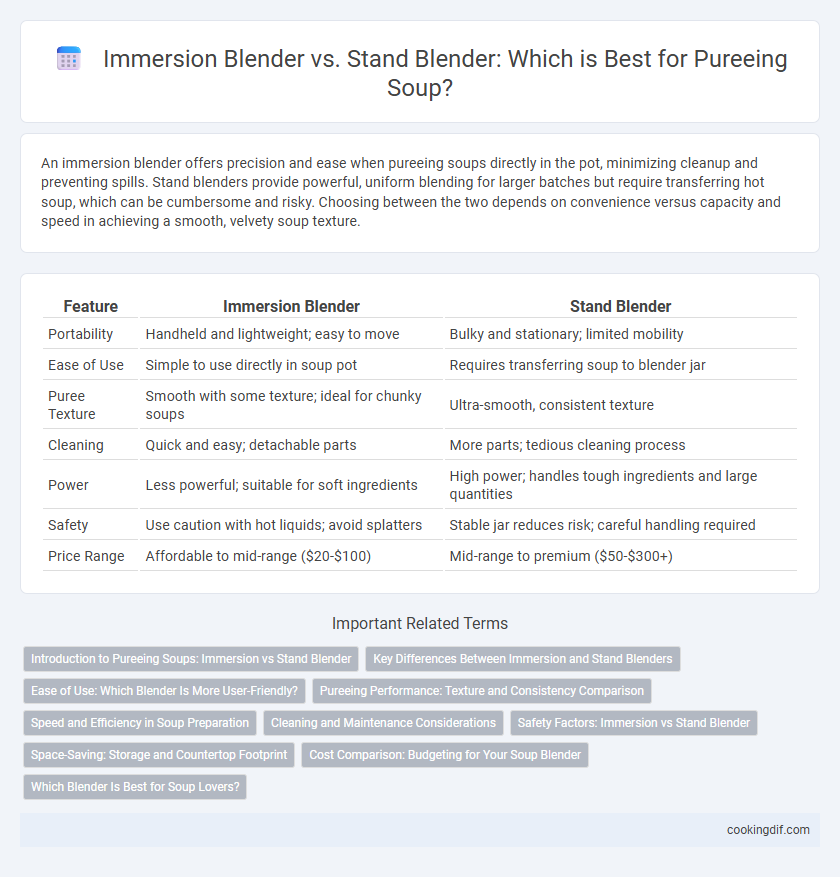An immersion blender offers precision and ease when pureeing soups directly in the pot, minimizing cleanup and preventing spills. Stand blenders provide powerful, uniform blending for larger batches but require transferring hot soup, which can be cumbersome and risky. Choosing between the two depends on convenience versus capacity and speed in achieving a smooth, velvety soup texture.
Table of Comparison
| Feature | Immersion Blender | Stand Blender |
|---|---|---|
| Portability | Handheld and lightweight; easy to move | Bulky and stationary; limited mobility |
| Ease of Use | Simple to use directly in soup pot | Requires transferring soup to blender jar |
| Puree Texture | Smooth with some texture; ideal for chunky soups | Ultra-smooth, consistent texture |
| Cleaning | Quick and easy; detachable parts | More parts; tedious cleaning process |
| Power | Less powerful; suitable for soft ingredients | High power; handles tough ingredients and large quantities |
| Safety | Use caution with hot liquids; avoid splatters | Stable jar reduces risk; careful handling required |
| Price Range | Affordable to mid-range ($20-$100) | Mid-range to premium ($50-$300+) |
Introduction to Pureeing Soups: Immersion vs Stand Blender
Immersion blenders offer precision and control for pureeing soups directly in the pot, making them ideal for small batches and minimal cleanup. Stand blenders deliver powerful, consistent blending suitable for large volumes, ensuring smooth textures but require transferring hot liquids carefully. Choosing between immersion and stand blenders depends on factors like batch size, texture preference, and kitchen convenience during soup preparation.
Key Differences Between Immersion and Stand Blenders
Immersion blenders feature a handheld design that allows direct blending inside pots, making them ideal for pureeing soups without transferring hot liquids. Stand blenders offer powerful motors and large capacities, enabling smoother textures and handling tougher ingredients but require transferring soup to the blender jug. Key differences include portability, ease of cleanup, and the ability to blend directly in the cooking vessel versus the superior power and versatility of stand blenders.
Ease of Use: Which Blender Is More User-Friendly?
Immersion blenders offer greater ease of use for pureeing soups directly in the pot, eliminating the need for transferring hot liquids and minimizing cleanup. Stand blenders require pouring the soup into the jar, which can be cumbersome and involve handling heavy, hot containers. Ergonomic design and one-handed operation make immersion blenders more user-friendly for quick and safe pureeing tasks.
Pureeing Performance: Texture and Consistency Comparison
Immersion blenders excel in pureeing soups directly in the pot, delivering smooth and consistent textures with minimal effort, making them ideal for small to medium batches. Stand blenders provide more powerful motors and larger capacity, achieving ultra-smooth purees but often require transferring hot soup, which can affect convenience and safety. Texture consistency is typically finer with stand blenders due to higher blade speed and thorough blending, while immersion blenders offer better control for chunkier or rustic soup textures.
Speed and Efficiency in Soup Preparation
Immersion blenders offer superior speed and efficiency for pureeing soups directly in the pot, reducing transfer time and minimizing cleanup. Stand blenders provide powerful motors and consistent texture but require additional steps of transferring hot soup, which can be time-consuming. For quick, efficient soup preparation, immersion blenders excel in preserving workflow and reducing prep time.
Cleaning and Maintenance Considerations
Immersion blenders offer a streamlined cleaning process with detachable, dishwasher-safe blades that minimize time spent on maintenance compared to stand blenders, which often require disassembling multiple parts and cleaning a bulky pitcher. Stand blenders excel at handling large batches efficiently but demand thorough cleaning to prevent residue buildup in hard-to-reach areas, increasing maintenance effort. Choosing between the two depends on balancing convenience in cleaning with blending capacity for pureeing soups.
Safety Factors: Immersion vs Stand Blender
Immersion blenders offer enhanced safety for pureeing hot soups as their handheld design prevents splattering and allows better control within the pot, reducing burn risks. Stand blenders require transferring hot liquids, increasing the chance of spills and burns due to splashes or lid failure. Choosing an immersion blender minimizes direct contact with hot surfaces and improves user safety during soup preparation.
Space-Saving: Storage and Countertop Footprint
An immersion blender offers a significant space-saving advantage with its compact design and minimal countertop footprint, ideal for kitchens with limited storage. Unlike a bulkier stand blender, it can be stored easily in a drawer or cabinet, freeing up valuable counter space. This makes the immersion blender a practical choice for quick pureeing tasks without sacrificing kitchen organization.
Cost Comparison: Budgeting for Your Soup Blender
Immersion blenders typically cost between $20 and $100, making them a budget-friendly option for pureeing soups directly in the pot. Stand blenders range from $50 to over $300, offering more power and capacity but requiring a higher upfront investment. For cost-conscious shoppers, immersion blenders provide an efficient and affordable solution without compromising texture quality.
Which Blender Is Best for Soup Lovers?
An immersion blender offers precise control and easy maneuverability for pureeing soups directly in the pot, preserving texture and minimizing cleanup. Stand blenders excel in achieving ultra-smooth, consistent blends with powerful motors ideal for large batches, though they require transferring hot soup carefully to avoid spills. Soup lovers seeking convenience and quick blending often prefer immersion blenders, while those prioritizing silky textures and volume may opt for stand blenders.
Immersion Blender vs Stand Blender for pureeing Infographic

 cookingdif.com
cookingdif.com